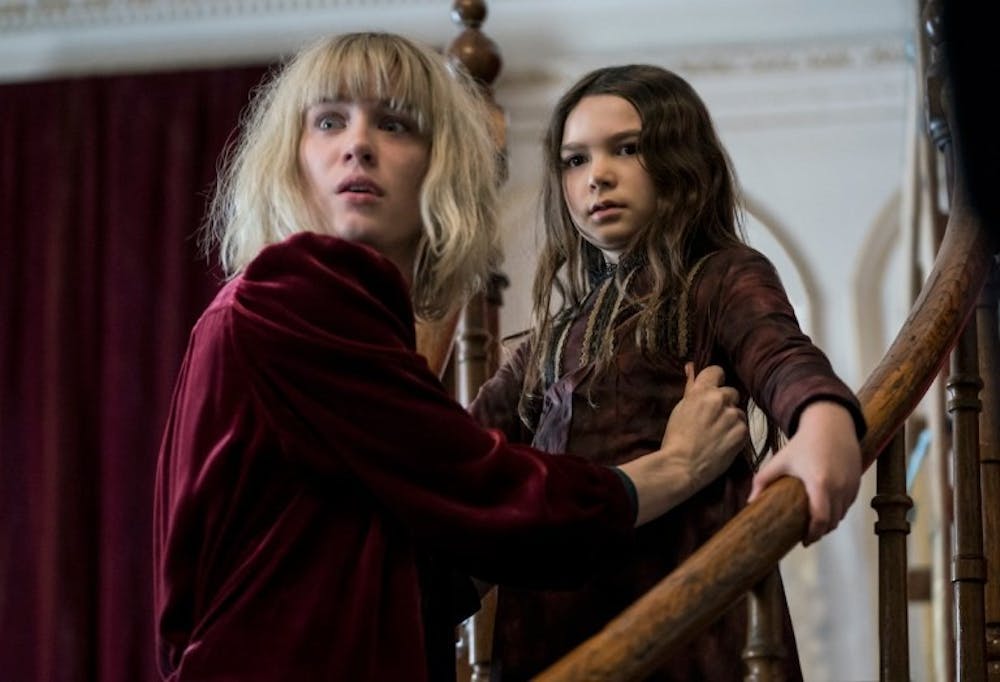The Turning could have been a perfectly fine movie. Perhaps it was destined to be a B–list horror flick with nothing new to say, a silly plot with a vaguely interesting premise, a promising setting (you can never go wrong with a haunted Victorian mansion), a pair of creepy kids, and some ominous spiders appearing out of nowhere. Yet, despite its decidedly okay production, it fumbles its way from alright into actively bad, leaving its audience with little more than angry grumbles.
To give credit where credit is due, it would be hard for The Turning to have a completely gripping plot. It's based off of Henry James’ Gothic novella, The Turn of the Screw, which was written in 1898. The Turning director Floria Sigismondi, though not the first to adapt James’ text to the big screen, is the first who attempts to bring it up to twenty–first century sensibilities. The film opens on a television screen discussing Kurt Cobain’s death—evidently placing the film in 1994—yet fails to actually make its newly updated timeframe a reflection of the text.

See, The Turning is about a young governess who moves into the home of two orphans, a boy named Miles (Finn Wolfhard) and a girl named Flora (Brooklynn Prince), in order to educate them. She soon uncovers a darker history hidden in the mansion. While this premise itself is outdated, the writers fail at modernization—Kate Mandell’s (Mackenzie Davis) move into the magnificent, luxurious home of the Fairchild family feels particularly strange because the very concept is so outdated that it’s incomprehensible. The movie, however, is aware of this confusion. When the housekeeper, Mrs. Grose (Barbara Marten), asks Kate when she was last a live–in governess, she jokes that she hasn’t “since the 1800s.” Kate’s job position, her demeanor with Miles, and her peculiar style of dress—who still wears lacey white nightgowns in the 1990s?—are all marvelously outdated, despite the movie’s lopsided attempt to renew the source material.
The movie also fails to actually make the old text exciting anew. Perhaps when James wrote The Turn of the Screw, its scares weren’t overdone, but by this point in horror film history, almost everything felt trite. The large, frightening house with scary paintings no longer seems very interesting. The spooky dolls which come to life, the creepy kids, the hushed whispers around the house—all of these things have been seen time and time again, yet lose their edge in this adaption. In fact, not a single scare of The Turning felt novel. It was very easy to not be frightened at all, despite a lovely plethora of cheap jump–scares. It wouldn't be hard to think of another movie that did it all and did it better, which would likely be a more enjoyable experience than sitting through The Turning.

But what is so bad about all of this? All of these aspects, while irritating, aren't particularly heinous. Unfortunately, The Turning goes off the rails in the final ten minutes, forgetting its source text. Here, the movie goes from bad to actively terrible, which prompted scoffing from those exiting the theater, and likely resulted in a 13% on Rotten Tomatoes.
In the background of The Turning is the main character’s mother, Darla (Joely Richardson), who is in a mental institution. She keeps on making charcoal drawings and sending them to Kate. This aspect, of course, was not present in James’ text, and it stands out like a sore thumb in an otherwise fairly contained plot. See, while Kate’s backstory remains entirely irrelevant for the majority of the film, in the final ten minutes, the movie turns itself on its head. (Spoilers ahead.)

We watch Kate, Miles, and Flora escape the house and the ghosts, driving out through the vaguely haunted gateway before it fades to black. A few seconds later, we see that this entire sequence was really just Kate imagining the future while looking into her mother’s painting. Turns out, Kate actually is crazy. She goes to the children, telling them to admit that they see the ghosts, before the scene abruptly shifts to Kate in the mental institution, visiting her mother. She approaches the figure, tries to speak to her, and then gets a glimpse of her face—unseen to the audience. She screams. Then, the credits roll.
It feels particularly cheap for the main character to have been hallucinating the entire time, and it’s a rudely abrupt ending to a movie that wasn’t good enough to warrant a smug cliffhanger. Perhaps if The Turning had been better, it could’ve earned such a self–satisfied ending, but because of its sluggish plot, confusing setting, and boring scares, it earns its title as a movie that's not just bad, but actively horrible.







